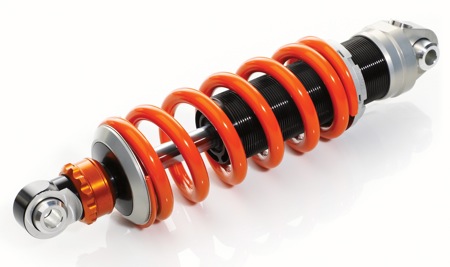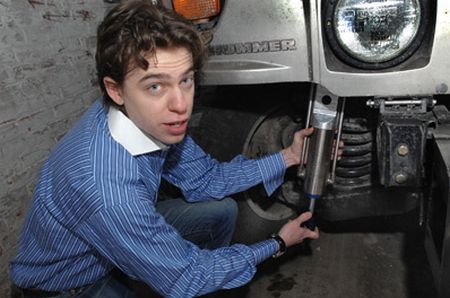Most vehicles are equipped with a conventional shock absorber at each corner or with a MacPherson strut shock absorber in each front corner and a conventional shock absorber in each rear corner.

A conventional shock absorber is a fluid-filled sealed chamber that is separate from the coil spring with which it works. A MacPherson strut shock absorber is a fluid-filled sealed chamber that is combined into an assembly with its coil spring. Unless designated otherwise, the term “shock absorber” is used here to apply to both conventional and MacPherson strut shock absorbers.
Despite the term, a shock absorber does not absorb shocks transmitted to a vehicle as it negotiates defects and obstacles such as potholes and railroad tracks. Absorbing road shock is the task of the coil springs.
The job of shock absorbers is to counteract the action of springs. If it weren’t for shock absorbers, the vehicle would continue to bounce as long as springs compressed and recoiled.
Coil springs seldom fail. The same can’t be said of shock absorbers. With vehicles that have been driven 25,000 miles or more, the main reason for bounce and shimmy when going over bumps is failure by one or more shock absorbers.
Indiscriminately replacing shocks without some evidence of failure, however, is not a wise course of action. You could be barking up the wrong tree and incur an unnecessary expense, because shimmy and bounce can also be caused by a worn or damaged component in the steering or suspension system, by misalignment, or by unbalanced wheel assemblies.
Here is how to find out whether your problem is caused by damaged shock absorbers:
- When the vehicle is on a hoist during an engine oil change, inspect each shock absorber for traces of fluid on the case, for dents in the case, and for cracks in each bushing. Bushings are donut-shaped rubber inserts that support the upper and lower fasteners that hold the shock to the frame of the vehicle.
- Another way to detect shock absorber failure is to drive over a railroad track crossing at 35 to 45 mph. If the vehicle bounces or shimmies, shocks are probably damaged.
It is not particularly difficult to replace conventional shock absorbers. MacPherson struts are a different matter, as are shock absorbers in vehicles with automatic level control. To prevent damage to the car and possible injury, let a professional technician replace these for you.
If you decide to try your hand at replacing conventional shock absorbers, be aware that you will be working under a raised car. If you do not have the equipment mentioned below to securely support the vehicle, do not proceed.
Conventional shock absorbers in the front and conventional shock absorbers in the rear are removed from the vehicle differently.
Working in the front, with all wheels still on the ground, look in the engine compartment to determine whether the tops of the shock absorbers are to be loosened from that position. If dust shields are inserted into access holes cut into the fenders, pry off the shields to reach the fasteners that secure the tops of the shock absorbers to the vehicle. If the tops of front shock absorbers can’t be reached through the engine compartment, then they are designed to be loosened from under the car.
With an automatic transmission in Park or a manual transmission in gear, and with the parking brake securely engaged, raise the front of the car, place jack stands under the lower suspension arms, and lower the front of the car squarely onto the jack stands. Then, place wheel chocks firmly against the rear tires.
If you determine that the tops of the shock absorbers are designed to be loosened from under the vehicle, remove the wheel and tire assemblies to see whether you can reach the fasteners through the wheel wells. If the hardware can be removed from inside the engine compartment, after prying off dust shields, loosen and remove the retainer caps that cover the threaded shafts of the shock absorbers. Then, take off the bushings and nuts.
When the tops of the shock absorbers are free, remove nuts and bolts that are holding the lower parts of shocks to the vehicle.
Working in the rear, determine whether the top shock absorber mounts are reached from inside the cargo compartment, from under the rear seat (which then must be removed), or from under the vehicle. With an automatic transmission in Park or a manual transmission in gear, and with the parking brake securely engaged, shove chocks against the front tires. Then, raise the back end of the vehicle. Position two jack stands under the rear axle, with each jack stand placed as close as possible to each shock. Lower the vehicle squarely onto the jack stands. Now, following the same steps described above for removing front shock absorbers, remove the rear shock absorbers.
Before installing new shock absorbers, extend and compress the units several times. This is done to expel air, which could interfere with shock absorber action, that may be trapped in a shock absorber tube. When installing new units, make sure that upper and lower fasteners are tightened as much as possible.










Dear Purchasing Manager,
Nice to meet you,
Thanks for your time to read the mail.
It’s my pleasure to know you from the internet.
Glad to know you are in the market of car parts.
You will never regret to cooperate with us because we are one of the largest manufacturers in Taiwan with the latest technology and a superior R&D team.
We believe you will be satisfied with our products if you are searching for a reliable supplier in this field.
You can try to visit our website: http://www.dgr.com.tw/ to get some further information.
If there are any other commodities you are interested in, please feel free to contact us.
Wish our products will be helpful for your business.
Your reply will be greatly appreciated.
I look forward to hearing from you.
Best Regards
Meg
Zi-He CO., Ltd.
Tel:886-4-25631595
Fax:886-4-25620511